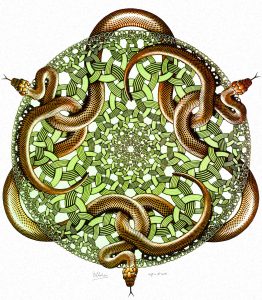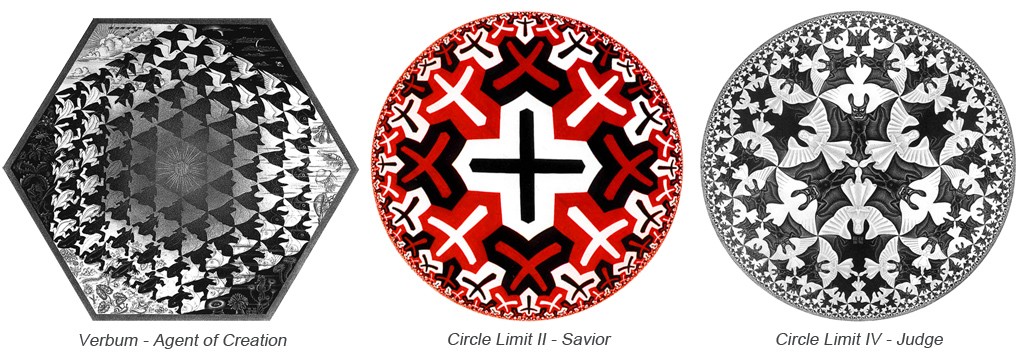(1)
To wrap up the Christian Morphing posts we’re going to take a closer look at Dutch Graphic Artist M.C. Escher and his last print: Snakes.
Escher had unique abilities, he paid attention to the smallest details, and created amazing works of art. Ever curious, ever onto the next print, and ever addicted to the joy of intellectual discovery. Over time, Escher grew as an artist, and he often returned to previous subject matters. He depicted the old subjects in new ways, demonstrating how far he’d come. The series of mandalas he created later in his career brought greater depth to his treatment of Biblical themes.
Escher visualized, created, and turned his discoveries into prints and into art. He lived Dr. Medina’s Brain Rules. It’s not surprising that we find the brain rules in Escher’s artistic statements.
As a result, Escher morphed. Morphed from a young man who made simple portraits to a mature artist who opened new worlds for us. He left an impressive body of work for us to marvel at and enjoy.
Escher was also a driven man, working relentlessly on the problems he was trying to solve. In a discussion on tessellations, Escher writes: “However, designing new motifs still remains an extremely strenuous activity. It is a real ‘mania’ to which I became addicted, and from which I can hardly tear myself away sometimes.”2 I didn’t fully appreciate how demanding Escher’s efforts were until I tried to re-create his work.
Finally, Escher pursued onward to the very end. Snakes was done at the end of his life. Escher’s friend, Bruno Ernst writes about the print: “…he wasn’t going to divulge any more about it [to me]. I was not even allowed to see the preparatory studies. He was staking everything on getting the print finished and he could not put up with any criticism at all, for he was afraid that this might take away his keenness to pursue it.”3
Put another way, Escher is in his early 70’s, and his health is failing. He will die within a few years, but he wants to create one more work of art, and he isn’t going to let anything get in his way.
Let’s take a closer look at Snakes. The previous Circle Limit prints are generally flat feeling.
Escher’s Mandalas (4,5,6)
With Snakes, Escher found a way to illustrate a progression from an infinite number of circles in the center to a finite number in the middle, back to infinite at the print’s edge. Escher also added dimensionality to this piece of art that wasn’t present in the previous Circle Limit mandalas. The snakes are moving both in front of and behind the circles. The snakes are highlighted at the top, and are casting shadows onto the rings below them. Not only that, but the rings themselves are casting shadows upon themselves! It’s 3D!
Escher didn’t let up with his last print. Instead, he tried to take his work to a new level, and he succeeded. Not bad for a man in his 70’s without a computer. Even with a computer, and sophisticated 3D software, this print would be difficult to create.
This is what God intends for us as believers. We
- Morph
- Change
- Mature as Christians
In the end, we can join with the Apostle Paul and say:
6 For I am already being poured out as a drink offering, and the time of my departure has come. 7 I have fought the good fight, I have finished the race, I have kept the faith. 8 Henceforth there is laid up for me the crown of righteousness, which the Lord, the righteous judge, will award to me on that Day, and not only to me but also to all who have loved his appearing. 2 Timothy 4:6-8 (ESV)
Sources
- Snakes, M.C. Escher. Retrieved from mcescher.com and wikiart.org on January 15, 2016
- Escher, M.C. 1989, Escher on Escher: Exploring the Infinite, Page 103. New York, New York: Harry N. Abrams, Inc., Publishers.
- Ernst, Bruno. 1994, The Magic Mirror of M. C. Escher, Page 110. New York, New York: Barnes & Nobles, Inc., by arrangement with Taschen America L.L.C.
- Verbum, M.C. Escher. Retrieved from mcescher.com and wikiart.org on January 15, 2016.
- Circle Limit II, M.C. Escher. Retrieved from http://euler.slu.edu/escher/ on January 15, 2016.
- Circle Limit IV, M.C. Escher. Retrieved from mcescher.com and wikiart.org on January 15, 2016.


